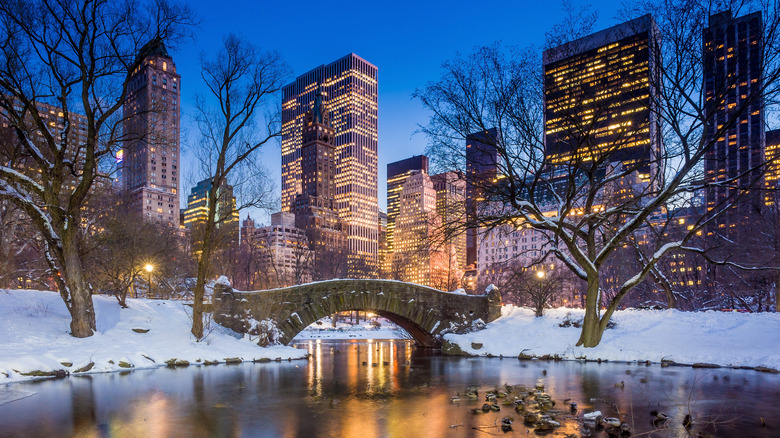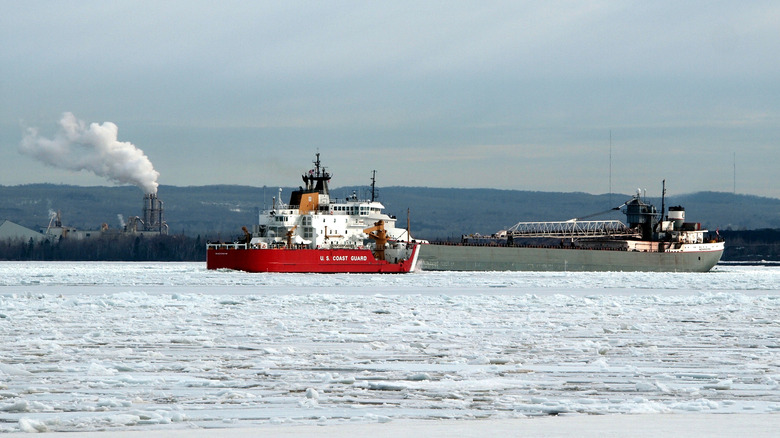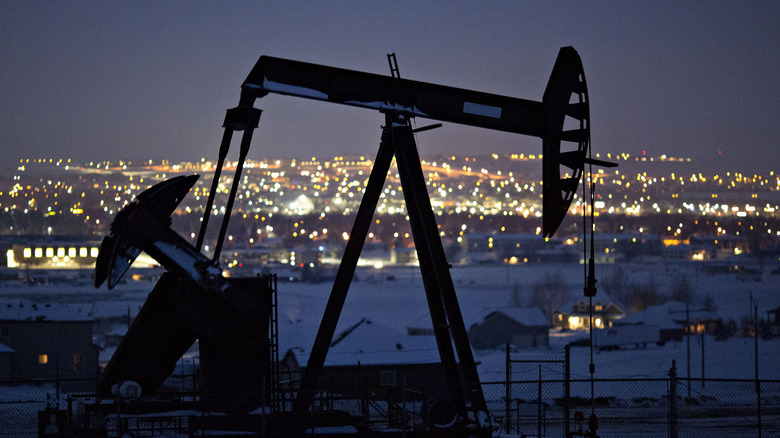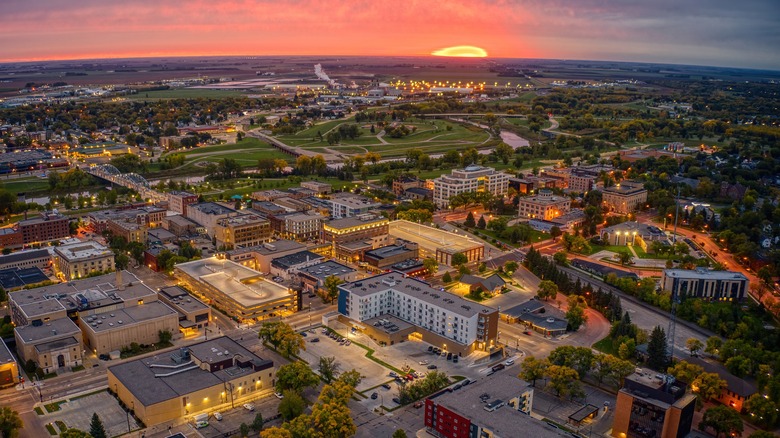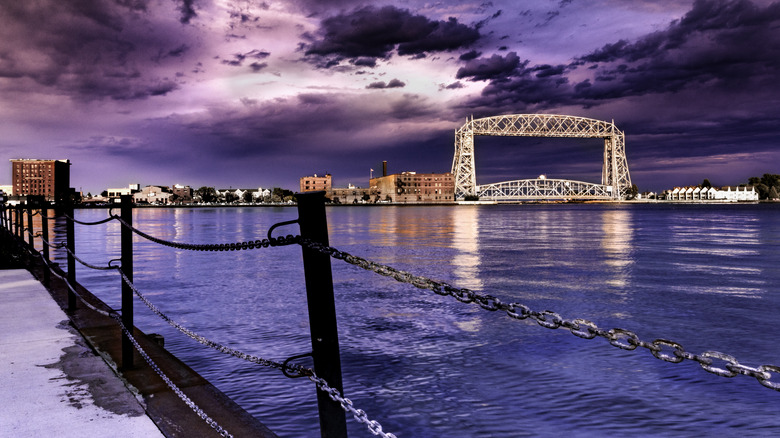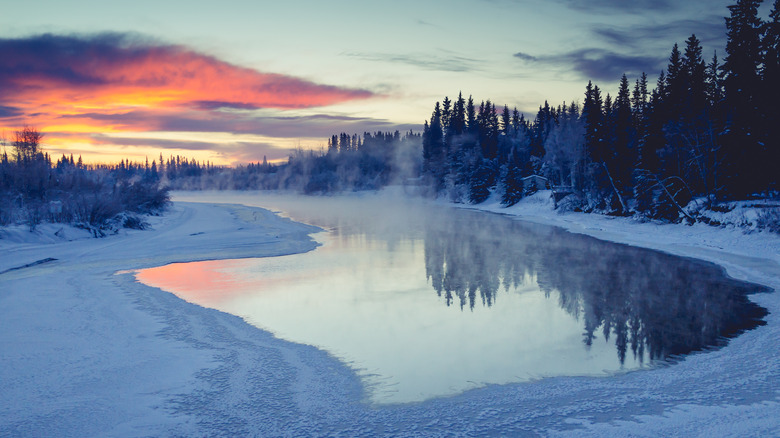The Best City To Live In If You Love Cold Weather
Do you like bundling up? From the Upper Peninsula to the North Star Borough, there are several northern cities that encompass some of the coldest temperatures in the United States, especially during winter. With comfortable temperatures generally present during the summertime, many of these northern territories can dip well below zero (to -20 degrees Fahrenheit), while most average numbers remain within frigid, single digits (via Current Results). As cold weather states like North Dakota and Minnesota compete with the icy glacier regions of Alaska, including the northern parts of South Dakota and Michigan, all these lands offer a variety of winter merriments and outdoor activities to choose from if you reside there.
What's the most popular cold city to live in? From skiing, snowboarding, and snowmobiling to snowshoeing, ice fishing, and fat tire biking, most all these states offer a variety of outdoor recreation several months out of the year. Places like Sault Ste. Marie, Michigan feature sleigh rides, outdoor hockey, and ice climbing, while Fairbanks, Alaska is the mecca for all things ice and snow, with ice art sculptures, dog mushing (sledding), Chena Hot Springs, and the captivating Northern Lights (Aurora borealis). Read on to discover more about these cold-climate cities and the best one that remains on the low for keeping it chill.
Sault Ste. Marie, Michigan
A friendly neighbor to Canada, Sault Ste. Marie stands out on its own as the sole town of Chippewa County and a chilling candidate. Situated on the northeastern point of Michigan's Upper Peninsula, the Sault (or Soo) possesses a deep-rooted Native American history, as it's one of the oldest and original cities, colonized by the French in the early 17th century. As the St. Mary's River flows through the town, Sault Ste. Marie also receives lake-effect weather with lots of rain, snow, and cloud coverage throughout the year, making January and February the most frigid months. According to Trip Advisor, the daily winter high may stay within the lower to mid-20s and drop to single digits or lower after the sun goes down. Spring and fall may bring more precipitation, while summer is the warmest with temperatures in the 70s and 80s.
With the chance of snow in the Soo ranging from October to April, there's a lot to do in the cold, wet climate. Locals might explore the many well-maintained trails for fat tire biking, snowshoeing, snowmobiling, and cross-country skiing like the Algonquin Cross-Country Ski Trail and Hiawatha Highlands. Outdoor skating/hockey rinks, sledding, tubing, ice climbing, and sleigh rides are also a must while out in the northern, frosty air.
Williston, North Dakota
With several bitter cold cities to consider in the state of North Dakota, Williston is one of the top locations and a great contender. The sixth largest city within one of the Great Plains states, Williston is situated on the northwestern side and features a portion of the Missouri River (the longest river in the U.S.), plus its rich agricultural and oil industries, which continue to thrive amidst a vast, sweeping landscape. Harsh wind and snow return each winter to Williston residents, as temperatures typically decline to a few degrees above zero for a daily high and might fall below -20 at night, on average (per Weather Spark).
There's a variety of snow sports to embrace during Williston's winter freeze like hitting the ski slopes, plus snowshoe and snowmobiling trails, including outdoor ice-skating rinks like Davidson Park and cross-country skiing at Fairview Bridge. The area also boasts some of the best freshwater river and lake fishing, whether it's ice or thawed, to catch rainbow and brown trout, including chinook salmon and walleye, among other gamefish.
Grand Forks, North Dakota
Home to the University of North Dakota, Grand Forks is a lively college town that features numerous cold-weather activities for everyone. The third largest city within the Peace Garden State, following Bismarck and Fargo, Grand Forks is situated on the border with Minnesota. With barren, flat land, Grand Forks sees some of the chilliest temperatures, especially through the winter wind chill that can result in snowdrifts and whiteouts (via Only In Your State). Typical winter lows fall just below zero with the lowest reported temperature at -43 degrees in January 2004. Summers are comfortable, as they can reach up to the 70s and 80s during the day with an average low of 55 degrees at night.
With a mostly suburban atmosphere, Grand Forks has thriving roots in the production and trade business of various crops like wheat, barley, beans, corn, and potatoes, among others, originating in the Red River Valley. A family-friendly area, The Grand Forks Park District offers winter recreation like cross-country ski trails, a skating rink, snowshoeing, sledding, and snowboarding areas, along with UND's hockey games at the Ralph Engelstad Arena.
Duluth, Minnesota
A close winner, Duluth, Minnesota is a chilled, port city on the corner cusp of Lake Superior that is known for its intense winter seasons. Being located directly on the lake water adds to the wind chill factor as well as bitter cold conditions. According to All American Atlas, Duluth's coldest temperatures are experienced from December to February, especially in January, with an average high of 25 degrees Fahrenheit and lows around 7 degrees Fahrenheit. During the most frigid time of January, the thermometer may descend, on average, to about -39 degrees Fahrenheit. One of the coldest temperatures occurred in the late 1800s at -41 degrees Fahrenheit.
Come winter, snowshoeing, skiing, snowboarding, and snowtubing are popular sports and recreation for Duluth residents. The eventful town also offers various museums, an aquarium, and the Lake Superior Zoo. The holidays bring walking outdoor Christmas light tours like The Bentleyville Tour of Lights, including notable sights like the Duluth Aerial Lift Bridge and the North Pier Lighthouse.
Fairbanks, Alaska
If you want to live in a cold climate, Fairbanks, Alaska is definitely the best city for you on this list. It offers some of the most specialized outdoor activities that you can't find anywhere else. Located in the interior region of Alaska's North Star Borough, The Golden Heart city presents an enchanting, frozen experience for its cold-loving residents, especially during winter. In the land of the midnight sun, Fairbanks usually receives nearly 24 hours of daylight during the summer and only a glimpse of it for up to five hours in winter, making the land persistently preserved and dark (via Explore Fairbanks). With the sun never completely setting from June to August, temperatures can vary from the upper 60s to the mid-70s during the day and stay in the 40s and 50s at night.
From long, light days to short dark ones, Fairbank's average winter temperatures remain below 16 degrees Fahrenheit for a daily high, with a nightly average of around -20 degrees Fahrenheit, making it the coldest city to live in within the U.S. (per Geophysical Institute). When winter arrives, you can take advantage of all things snow with skiing, snowboarding, snowshoeing, snowmobiling, dog sledding, and the awe-inspiring ice sculpture season (February-March), including the epic Castner Glacier Cave. Typically present from August to April, thousands of visitors are captivated by the mesmerizing colors of the Northern Lights, which can be seen in a little town called the North Pole, located only 20 minutes southeast of Fairbanks.
